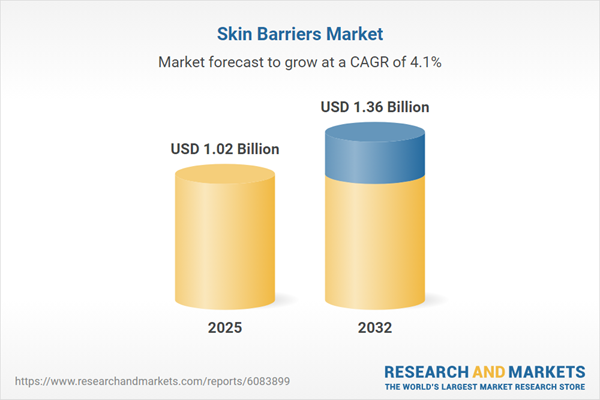Speak directly to the analyst to clarify any post sales queries you may have.
The skin barriers market is experiencing a period of robust transformation, as both medical and consumer sectors increasingly prioritize advanced protection and healing solutions. New technologies, shifting regulations, and rising demand for multifunctional formulations are driving stakeholders to adapt and innovate in response to evolving care needs.
Market Snapshot: Global Growth Trajectory and Skin Barriers Market Overview
The skin barriers market grew from USD 987.88 million in 2024 to USD 1.02 billion in 2025. It is expected to progress at a compound annual growth rate (CAGR) of 4.08%, projecting a value of USD 1.36 billion by 2032. This momentum is underpinned by surging interest in protective products across healthcare and personal care markets, as businesses and end-users align with new therapeutic and preventive demands in skin management.
Scope and Segmentation of the Skin Barrier Solutions Market
This report delivers insights into the expanding landscape of skin barrier solutions, offering a comprehensive analysis of product differentiation, application context, distribution methods, end-user environments, technological advancements, and ingredient trends.
- Product Type: Creams (medicated and nonmedicated), film forming spray, liquid spray, ointment
- Application: Medical (burn care and wound care), personal care (cosmetic applications and daily skin care)
- Distribution Channel: Offline (pharmacy store, retail store), online (direct sales, e-commerce platforms)
- End User: Clinics, homecare, hospitals, pharmacies
- Technology: Hydrogel, polymer based, silicone based
- Ingredient Type: Natural, synthetic
- Regions Covered: Americas (North America—United States, Canada, Mexico; Latin America—Brazil, Argentina, Chile, Colombia, Peru), Europe, Middle East & Africa (Europe—United Kingdom, Germany, France, Russia, Italy, Spain, Netherlands, Sweden, Poland, Switzerland; Middle East—United Arab Emirates, Saudi Arabia, Qatar, Turkey, Israel; Africa—South Africa, Nigeria, Egypt, Kenya), Asia-Pacific (China, India, Japan, Australia, South Korea, Indonesia, Thailand, Malaysia, Singapore, Taiwan)
- Key Companies Analyzed: 3M Company, Johnson & Johnson, ConvaTec Group plc, Coloplast A/S, Hollister Incorporated, Smith & Nephew plc, Mölnlycke Health Care AB, Paul Hartmann AG, Essity Aktiebolag (publ), Medline Industries, L.P.
Key Takeaways for Senior Decision-Makers
- Growing demand for next-generation skin barrier products is fueled by increased awareness of skin health and the convergence between medical and personal care needs.
- Innovations in hydrogels and silicone-based systems are supporting the shift from traditional wound management toward proactive, patient-centered protection strategies.
- Consumer preferences are rapidly evolving, with transparency, sustainability, and ease of use now pivotal in product selection and loyalty.
- Digital transformation is enabling remote monitoring and data-driven product enhancements, supporting more personalized skin barrier solutions across clinical and consumer environments.
- Strategic collaborations and mergers are redefining competitive dynamics, facilitating access to new markets and supporting accelerated product development cycles.
Tariff Impact: Navigating Shifts in Global Trade and Cost Structures
The enactment of new United States tariffs in 2025 is prompting industry leaders to reconsider sourcing strategies for key materials. Heightened duties on polymers and packaging components are impacting cost structures and supply chain reliability. Organizations are responding by exploring alternative suppliers, reassessing inventory models, and leveraging digital procurement tools to build resilience and preserve margins. Strategic nearshoring and regional partnerships are gaining traction, as is investment in in-house manufacturing capabilities to hedge against volatility.
Methodology & Data Sources
This report integrates qualitative and quantitative approaches, including interviews with key stakeholders, structured end-user surveys, and targeted secondary data from regulatory filings, trade associations, and industry literature. Quantitative analysis links segmentation categories to adoption patterns and examines scenario models for potential supply chain disruptions.
Why This Report Matters: Strategic Value for Industry Leaders
- Enables data-driven decision-making by delivering actionable segmentation insights and competitive intelligence for strategic planning.
- Equips teams with a clear understanding of regional adoption patterns and technology trends to inform high-impact market entry and product development strategies.
Conclusion
Senior leaders who prioritize innovation, operational agility, and targeted stakeholder engagement will be positioned to adapt to changing skin barrier solution demands and unlock new sources of competitive value in this evolving market landscape.
Table of Contents
3. Executive Summary
4. Market Overview
7. Cumulative Impact of Artificial Intelligence 2025
Companies Mentioned
The companies profiled in this Skin Barriers market report include:- 3M Company
- Johnson & Johnson
- ConvaTec Group plc
- Coloplast A/S
- Hollister Incorporated
- Smith & Nephew plc
- Mölnlycke Health Care AB
- Paul Hartmann AG
- Essity Aktiebolag (publ)
- Medline Industries, L.P.
Table Information
| Report Attribute | Details |
|---|---|
| No. of Pages | 183 |
| Published | November 2025 |
| Forecast Period | 2025 - 2032 |
| Estimated Market Value ( USD | $ 1.02 Billion |
| Forecasted Market Value ( USD | $ 1.36 Billion |
| Compound Annual Growth Rate | 4.0% |
| Regions Covered | Global |
| No. of Companies Mentioned | 11 |









